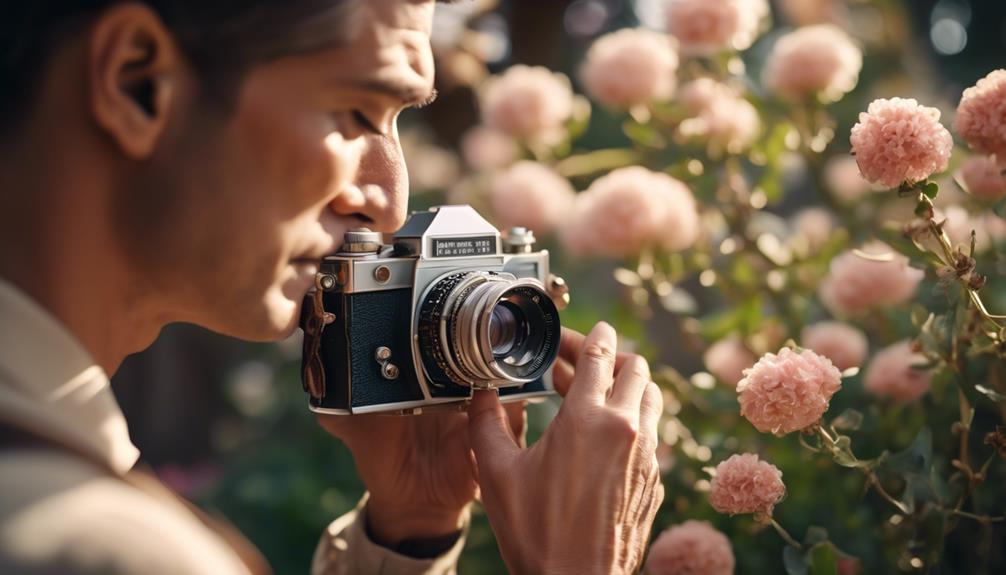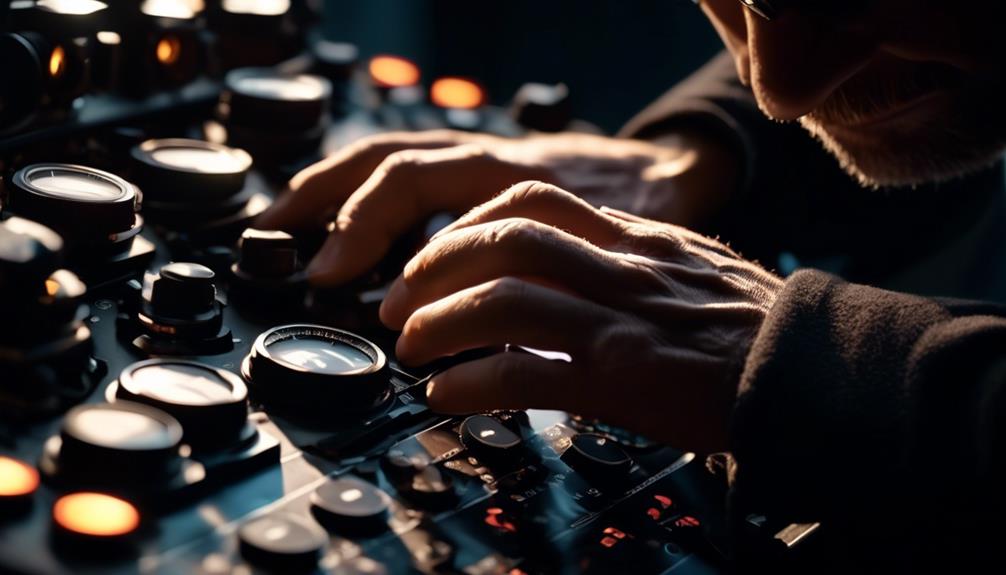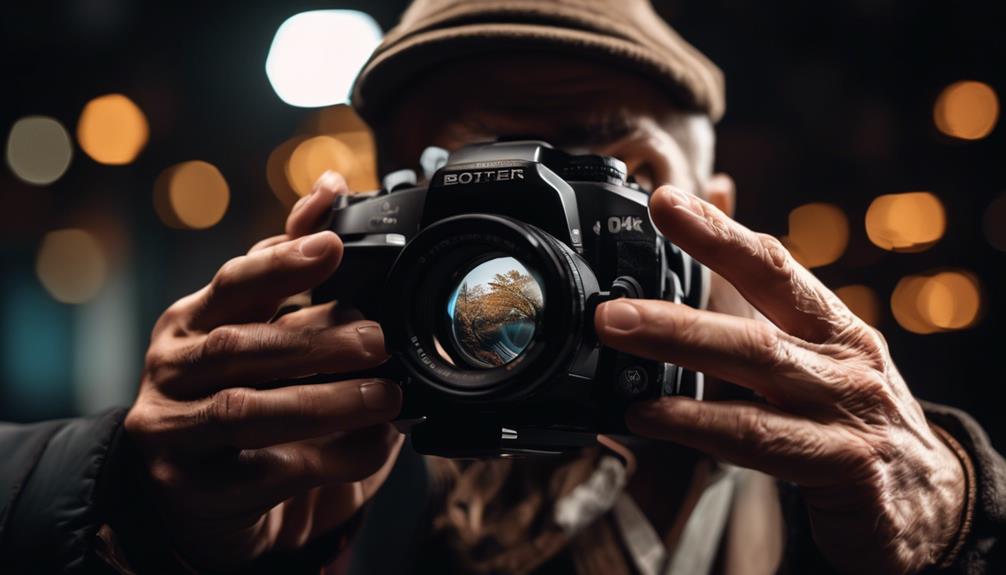Please note this post may contain affiliate links picked by me (Jay) that I have deemed may be of interest or relevant to you the reader of this.
These links do not affect the cost of the thing if you decide to purchase but i may get a little money if you choose to purchase.
For more information on my affiliate link policy click here.
As I step into the world of photography, I find myself navigating through a labyrinth of settings, each one like a puzzle piece waiting to be perfectly aligned.
But fear not, fellow shutterbugs, for I have discovered the key to unlocking the secrets of manual camera settings. In this guide, we will delve into the mystical realms of ISO, aperture, and shutter speed, uncover the hidden truths of the exposure triangle, and unlock the power of customizing white balance.
But that's not all, my friends. We will also explore the intricate world of metering modes and master the art of manual focus techniques.
So, strap on your camera straps and join me on this journey of capturing moments like a true pro.
Key Takeaways
- Understanding the relationship between ISO, aperture, and shutter speed is crucial for mastering manual camera settings.
- Manual camera settings allow for precise control over lighting and exposure in photographs.
- Manipulating shutter speed can create artistic effects, such as capturing motion or creating long exposure images.
- Utilizing metering modes and focus techniques can enhance the sharpness and accuracy of images.
Mastering ISO, Aperture, and Shutter Speed
Mastering ISO, aperture, and shutter speed is the key to unlocking the full potential of your manual camera settings. It's like having a superpower that allows you to capture stunning photographs with precision and creativity. By understanding how these three elements work together, you can achieve breathtaking effects that will leave your audience in awe.
Balancing natural light with artificial lighting is an essential skill for any photographer. With manual camera settings, you have the power to control the amount of light that enters your camera. By adjusting the aperture, you can determine the depth of field, creating a sharp subject with a beautifully blurred background. Combine this with the right ISO setting, and you can capture a well-exposed image even in low light conditions. This knowledge empowers you to create captivating images no matter the lighting situation.
Another exciting aspect of mastering these settings is the ability to achieve long exposure effects. By manipulating the shutter speed, you can capture motion in a way that the human eye can't perceive. Whether it's capturing the smooth flow of a waterfall or creating light trails from passing cars, long exposure photography adds a touch of magic to your images. It allows you to freeze a moment in time or create a sense of movement, giving your photographs a dynamic and artistic feel.
As you delve into the world of manual camera settings, you'll discover endless possibilities for innovation. With a solid understanding of ISO, aperture, and shutter speed, you can confidently explore your creative vision and capture images that truly stand out. So grab your camera, experiment with different settings, and unlock the full potential of your manual camera settings. The world is waiting to see your unique perspective.
Understanding Exposure Triangle
Now that we've a solid understanding of ISO, aperture, and shutter speed, let's dive into the fascinating world of the exposure triangle and uncover the key to achieving perfectly balanced exposures in your photographs.
The exposure triangle is the relationship between these three elements, and by manipulating them, you can control the amount of light that enters your camera and ultimately, the exposure of your image.
To balance exposure in high contrast situations, where you have both bright and dark areas in the same frame, you need to find the right combination of ISO, aperture, and shutter speed. For example, if you're shooting a landscape with a bright sky and dark foreground, you can use a smaller aperture to decrease the amount of light coming in, a faster shutter speed to reduce the exposure time, and a lower ISO to minimize noise. This will help you capture both the details in the sky and the foreground without losing any information.
Another technique you can use to achieve long exposure photography is by using ND filters. These filters reduce the amount of light that enters your camera, allowing you to use slower shutter speeds even in bright conditions. This is especially useful for capturing smooth, silky waterfalls or blurred clouds in the sky. By using a combination of a small aperture, low ISO, and a long exposure time with the help of ND filters, you can create stunning images with motion blur that adds a sense of drama and movement.
Understanding the exposure triangle is essential for mastering manual camera settings. It gives you the power to control the exposure of your photographs and create the images you envision.
Customizing White Balance for Perfect Colors
To achieve vibrant and accurate colors in your photographs, it's crucial to customize the white balance settings of your camera. White balance refers to the adjustment of color temperature to ensure that the whites in your photos appear truly white, regardless of the lighting conditions. By customizing the color temperature, you can create stunning images that accurately represent the colors of the scene.
Here are three ways to customize white balance for perfect colors:
- Using White Balance Presets: Many cameras come with built-in white balance presets that are designed to adjust color temperature based on different lighting conditions. These presets include options such as daylight, cloudy, shade, tungsten, fluorescent, and flash. By selecting the appropriate preset, you can quickly and easily achieve accurate colors in different situations.
- Manual Kelvin Adjustment: If you want more control over the color temperature, you can manually adjust the Kelvin value on your camera. This allows you to fine-tune the white balance based on your specific needs. For example, if you're shooting during sunset and want to enhance the warm tones, you can increase the Kelvin value to create a richer and more dramatic effect.
- Custom White Balance: For the most accurate colors, you can create a custom white balance setting by using a white or gray card. Simply place the card in the same lighting conditions as your subject, take a photo of it, and then use that photo as a reference for setting the white balance. This method ensures that the colors in your photos are true to life and eliminates any unwanted color casts.
Utilizing Metering Modes for Accurate Exposure
After mastering the art of customizing white balance for perfect colors, the next step in achieving professional-level manual camera settings is to utilize metering modes for accurate exposure. Evaluating different metering modes is crucial in ensuring that your photos are properly exposed. Metering modes determine how your camera measures the light in a scene and calculates the exposure settings. By understanding and utilizing the various metering modes available on your camera, you can capture stunning images with accurate exposure in any lighting situation.
One of the most commonly used metering modes is the 'Matrix' or 'Evaluative' mode. This mode analyzes the entire scene and takes into account different factors such as brightness, contrast, and color to determine the optimal exposure settings. It's a versatile mode that works well in most situations, making it a popular choice among photographers.
If you find yourself shooting in a high-contrast scene, such as a backlit subject, the 'Spot' metering mode may be more suitable. This mode measures the light from a small area in the center of the frame, allowing you to expose for your subject accurately. It's particularly helpful when your subject is significantly brighter or darker than the surrounding environment.
For situations where you have a dominant light source, such as a brightly lit window, the 'Center-Weighted' metering mode can be effective. This mode measures the light in the entire frame but gives more importance to the central area, making it useful for portraits or close-up shots.
To achieve proper exposure in challenging lighting conditions, it's essential to understand and experiment with the different metering modes your camera offers. By evaluating these modes and selecting the most appropriate one for each situation, you can ensure that your photos are correctly exposed, capturing all the details and creating visually stunning images. Remember to review your camera's manual for detailed instructions on how to switch between metering modes and to practice using them in various shooting scenarios.
Mastering Manual Focus Techniques
Mastering manual focus techniques is an essential skill that allows photographers to have complete control over their image sharpness and creative vision. With manual focus, you can achieve precise focus on your subject and create stunning images that stand out from the crowd.
Here are three key techniques to help you master manual focus:
- Focus Peaking: This feature, available in many modern cameras, highlights the areas in focus by overlaying a colored outline on the subject. By adjusting the focus ring, you can easily identify the sharpest areas in your frame, especially useful when shooting macro photography or capturing intricate details.
- Magnification: Utilizing the magnification feature enables you to zoom in on your subject while focusing. This allows for accurate fine-tuning of focus, particularly in situations where precise focus is crucial, such as macro photography. By magnifying the view, you can ensure that every detail is tack sharp.
- Focus Bracketing: This technique involves taking a series of shots with slightly different focus distances. It's particularly useful in macro photography, where depth of field is often shallow. By combining these shots in post-processing, you can create an image with a larger depth of field, ensuring that your subject is sharp from front to back.
Frequently Asked Questions
What Are Some Common Mistakes to Avoid When Using Manual Camera Settings?
When using manual camera settings, it's important to avoid common mistakes like incorrect white balance and improper ISO settings. These errors can greatly affect the quality of your photos.
White balance ensures accurate color representation, so be sure to adjust it properly for different lighting conditions.
Additionally, setting the ISO too high can result in noisy and grainy images.
How Can I Ensure Sharp Focus in My Photographs When Using Manual Focus Techniques?
To ensure sharp focus in my photographs using manual focus techniques, I've mastered a few key techniques.
First, I always use the focus peaking feature on my camera, which highlights the areas in focus.
Secondly, I utilize the magnification feature to zoom in and check for precise focus.
Lastly, I take my time and make small adjustments to the focus ring until everything looks tack sharp.
These techniques have transformed my images and taken my photography to the next level.
What Are Some Tips for Achieving the Correct Exposure When Using Manual Camera Settings?
To achieve the correct exposure using manual camera settings, here are some tips I swear by.
Firstly, adjust the shutter speed to control the amount of light entering the camera. A faster shutter speed freezes motion, while a slower speed creates motion blur.
Secondly, tweak the aperture to determine the depth of field. A wider aperture creates a shallow depth of field, while a smaller aperture increases the area in focus.
Lastly, use a light meter to measure the available light and adjust your settings accordingly.
These tips will ensure perfectly exposed shots every time.
Are There Any Specific Camera Models or Brands That Are Better Suited for Manual Shooting?
For manual shooting, some camera brands excel in providing the best tools and features. When it comes to capturing stunning images with complete control, Nikon and Canon are among the top contenders.
Their camera models like the Nikon D850 and Canon EOS 5D Mark IV offer exceptional manual shooting capabilities. With high-resolution sensors, advanced autofocus systems, and extensive manual control options, these cameras empower photographers to unleash their creativity and capture breathtaking shots with ease.
Can I Still Use Automatic Shooting Modes While Also Utilizing Manual Camera Settings?
Yes, you can definitely combine automatic shooting modes with manual camera settings. It's a great way to have more control over your shots while still taking advantage of the convenience of automatic modes.
The advantages of using automatic shooting modes include faster shooting and easier exposure settings.
However, using manual camera settings allows you to fine-tune your images and get more creative.
It's all about finding the right balance between convenience and control to achieve the best results.
Conclusion
In conclusion, mastering manual camera settings is the key to unlocking your inner photography pro. By understanding ISO, aperture, and shutter speed, you can capture stunning images in any lighting conditions.
The exposure triangle guides you in balancing these settings for the perfect shot. Don't forget to customize white balance for vibrant colors, and utilize metering modes for accurate exposure.
And with practice, you'll become a master of manual focus techniques.
So grab your camera and get ready to take your photography to new heights!


